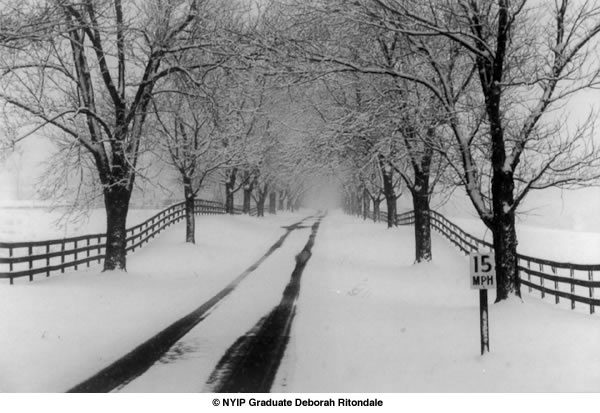
At the beginning of every Picture of the Month article NYIP has duly informed its readers of the familiar NYIP Guidelines that apply to all photographs. I suggest that you familiarize yourself with them if you haven´t yet done so. Then, as you read the evaluation of this month's picture, see if you can identify the use of the guidelines as you study the photograph. It's a good exercise and it will prove to you that you thoroughly understand the concepts we teach.
This month's photograph, made by NYIP Graduate Deborah Ritondale of Briston, Virginia, makes excellent use of converging lines in three different ways: the automobile tracks in the snow, the fences on either side of the road, and the trees lining both sides.† Repetition in any form, whether by subject matter, by shape, by color, or whatever, will almost always strengthen the picture just as repetition in writing, music, dance, etc. will reinforce the original concept.
Although the original photograph is in color, the picture is essentially monochromatic and made up of various shades of gray ranging from dark to light. The one obvious bit of color seems to be the yellow road sign advising us that the speed limit is 15mph. Worthy advice, too, considering the icy road conditions that seem to prevail in this wintry scene.
This picture makes obvious use of geometry (the leading lines) as prime compositional elements. But surely the shades of gray, coupled with the modicum of yellow, serve to establish the mood of the picture. And what is that mood?
That is something that you, the viewers, must decide. Moods, and feelings in general, are subjective to the nth degree. Artists can suggest to you, even give you specific direction, but you ultimately know how the picture affects you. Chacun à son goût (each one to his own taste), as the French say.
I personally feel that there is some sense of mystery here, a feeling of the unknown or at least unexpected. I wonder what lies at the end of the road, but I dare not hazard a guess. The road ends at the horizon's vanishing point, but it is shrouded in fog. And fog, beautiful as it may be, carries with it a possible dread, unanticipated peril. Some, like Carl Sandburg, found fog enchanting. "The fog comes on little cat feet/it looks over harbor and city on silent haunches and then moves on." The whimsy, for Sandburg, may have been evident, but for me the fog has an ominous quality. What about you?
The snow itself displays yet another mood. Read what John Greenleaf Whittier wrote about winter. "The sun that brief December day rose cheerless over hills of gray, and, darkly circled, gave at noon a sadder light than waning moon."
So many poets have found so much to say about the effects of winter, so well portrayed here in Ritondale's photograph. But I think Robert Frost summed it all up neatly when he wrote, "whose woods these are I think I know/he will not seem stopping here/the darkest evening of the year," and, "the woods are lovely, dark and deep, but I have promises to keep, and miles to go before I sleep, and miles to go before I sleep." For all us—you, me, every one of us—miles to go before we sleep.






